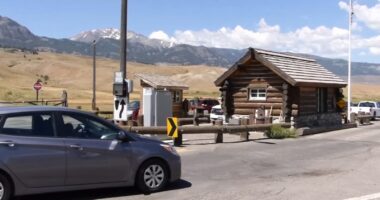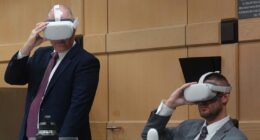In a swift and dramatic advance, insurgents made significant progress in Syria, approaching the capital and forcing government troops to vacate Homs. Despite speculation about President Bashar Assad’s escape, the government refuted such claims.
The fall of Homs represents a severe setback for Assad, given its strategic location linking Damascus with Latakia and Tartus, crucial regions supporting the Syrian leader and hosting a key Russian naval base.
Official reports from Sham FM mentioned government forces positioning themselves outside the country’s third-largest city, Homs, although details were scarce. Rami Abdurrahman, the director of the Syrian Observatory for Human Rights based in Britain, confirmed that Syrian military personnel and various security units had abandoned Homs, allowing rebel forces to gain control over parts of the city.
The insurgency announced later Saturday that it had taken over Homs. The city’s capture was a major victory for the rebels, who have already seized the cities of Aleppo and Hama, as well as large parts of the south, in a lightning offensive that began Nov. 27. Analysts said rebel control of Homs would be a game-changer.
The rebels’ moves around Damascus, reported by the monitor and a rebel commander, came after the Syrian army withdrew from much of southern part of the country, leaving more areas, including several provincial capitals, under the control of opposition fighters.
For the first time in the country’s long-running civil war, the government now has control of only three of 14 provincial capitals: Damascus, Latakia and Tartus.
The advances in the past week were among the largest in recent years by opposition factions, led by a group that has its origins in al-Qaida and is considered a terrorist organization by the U.S. and the United Nations. In their push to overthrow Assad’s government, the insurgents, led by the Hayat Tahrir al-Sham group, or HTS, have met little resistance from the Syrian army.
The rapid rebel gains, coupled with the lack of support from Assad’s erstwhile allies, posed the most serious threat to his rule since the start of the war.
The U.N.’s special envoy for Syria, Geir Pedersen, called Saturday for urgent talks in Geneva to ensure an “orderly political transition.” Speaking to reporters at the annual Doha Forum in Qatar, he said the situation in Syria was changing by the minute. Russian Foreign Minister Sergey Lavrov, whose country is Assad’s chief international backer, said he feels “sorry for the Syrian people.”
In Damascus, people rushed to stock up on supplies. Thousands went to Syria’s border with Lebanon, trying to leave the country.
Many shops in the capital were shuttered, a resident told The Associated Press, and those still open ran out of staples such as sugar. Some were selling items at three times the normal price.
“The situation is very strange. We are not used to that,” the resident said, insisting on anonymity, fearing retributions.
“People are worried whether there will be a battle (in Damascus) or not.”
It was the first time that opposition forces reached the outskirts of Damascus since 2018, when Syrian troops recaptured the area following a yearslong siege. The U.N. said it was moving noncritical staff outside the country as a precaution.

Syrian opposition fighters remove a government Syrian flag from an official building in Salamiyah, east of Hama, Syria Syria, Saturday Dec. 7, 2024. (AP Photo/Ghaith Alsayed)
Assad’s status
Syria’s state media denied social media rumors that Assad left the country, saying he was performing his duties in Damascus.
He has had little, if any, help from his allies. Russia is busy with its war in Ukraine. Lebanon’s Hezbollah, which at one point sent thousands of fighters to shore up Assad’s forces, has been weakened by a yearlong conflict with Israel. Iran has seen its proxies across the region degraded by regular Israeli airstrikes.
U.S. President-elect Donald Trump on Saturday posted on social media that the United States should avoid engaging militarily in Syria. Separately, President Joe Biden’s national security adviser said the Biden administration had no intention of intervening there.
Pedersen said a date for talks in Geneva on the implementation of a U.N. resolution, adopted in 2015 and calling for a Syrian-led political process, would be announced later. The resolution calls for the establishment of a transitional governing body, followed by the drafting of a new constitution and ending with U.N.-supervised elections.
Later Saturday, foreign ministers and senior diplomats from eight key countries, including Saudi Arabia, Russia, Egypt, Turkey and Iran, along with Pederson, gathered on the sidelines of the Doha Summit to discuss the situation in Syria.
In a statement, the participants affirmed their support for a political solution to the Syrian crisis “that would lead to the end of military activity and protect civilians.” They also agreed on the importance of strengthening international efforts to increase aid to the Syrian people.
The insurgents’ march
Rami Abdurrahman, who heads the Britain-based Syrian Observatory for Human Rights, an opposition war monitor, said insurgents were in the Damascus suburbs of Maadamiyah, Jaramana and Daraya. Opposition fighters were marching toward the Damascus suburb of Harasta, he added.
A commander with the insurgents, Hassan Abdul-Ghani, posted on the Telegram messaging app that opposition forces had begun the “final stage” of their offensive by encircling Damascus.
HTS controls much of northwest Syria and in 2017 set up a “salvation government” to run day-to-day affairs in the region. In recent years, HTS leader Abu Mohammed al-Golani has sought to remake the group’s image, cutting ties with al-Qaida, ditching hard-line officials and vowing to embrace pluralism and religious tolerance.
The shock offensive began Nov. 27, during which gunmen captured the northern city of Aleppo, Syria’s largest, and the central city of Hama, the country’s fourth-largest city.
Opposition activists said Saturday that a day earlier, insurgents entered Palmyra, which is home to invaluable archaeological sites had been in government hands since being taken from the Islamic State group in 2017.
To the south, Syrian troops left much of the province of Quneitra, including the main Baath City, activists said.
Syrian Observatory said government troops have withdrawn from much of the two southern provinces.
The Syrian army said in a statement that it carried out redeployment and repositioning in Sweida and Daraa after its checkpoints came under attack by “terrorists.” The army said it was setting up a “strong and coherent defensive and security belt in the area,” apparently to defend Damascus from the south.
The Syrian government has referred to opposition gunmen as terrorists since conflict broke out in March 2011.
Diplomacy in Doha
The foreign ministers of Iran, Russia and Turkey, meeting in Qatar, called for an end to the hostilities. Turkey is a main backer of the rebels.
Qatar’s top diplomat, Sheikh Mohammed bin Abdulrahman Al Thani, criticized Assad for failing to take advantage of the lull in fighting in recent years to address the country’s underlying problems. “Assad didn’t seize this opportunity to start engaging and restoring his relationship with his people,” he said.
Sheikh Mohammed said he was surprised by how quickly the rebels have advanced and said there is a real threat to Syria’s “territorial integrity.” He said the war could “damage and destroy what is left if there is no sense of urgency” to start a political process.

















